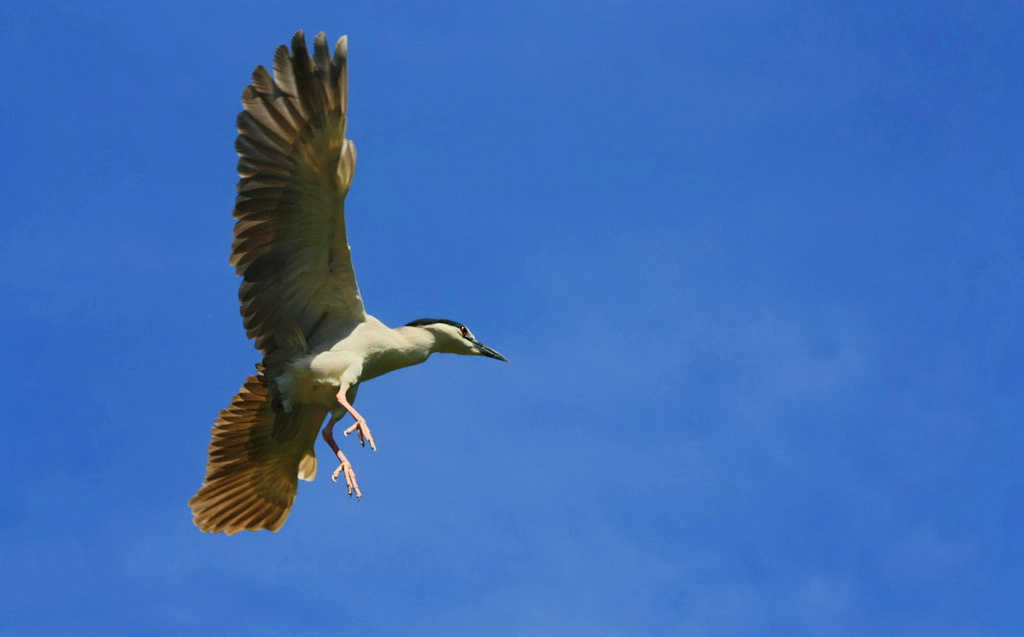
A black-crowned night heron over the University of Texas Southwestern Medical Center rookery in Dallas
By Melissa Gaskill
Texas Climate News
Climate change is forcing animals to change their behaviors. But can they make the right changes, and make them fast enough?
Probably not, concludes a recent paper in the scientific journal Nature Communications by an international team of 64 researchers that combed through more than 10,000 abstracts and data from 71 studies. The team looked for individual animals that are changing observable characteristics in association with climate change and examined whether such changes are adaptive, meaning they help the animals keep pace with what is happening in their environment. Adaptive changes are associated with desired outcomes, such as higher survival rates or increased number of offspring. For example, animals that breed earlier in response to increasing temperatures may have better reproductive success than those that do not change the timing of their breeding.
The paper reports that for birds in particular (the taxonomic group of animals best represented in the dataset), climate change has affected behavior – what scientists call phenological traits – but not morphological traits, or an animal’s physical characteristics. In addition, behavioral changes observed in birds often are adaptive. Birds can, for example, alter the timing of egg laying in response to triggers such as rainfall or temperature. Scientists also have seen shifts in the earliest seasonal movement of some migratory birds, as previously reported in Texas Climate News.
But even adaptive changes could prove too little, too late for some species.
“Climate change is just happening too quickly, and animals are not adapting fast enough,” Karl S. Berg, a professor at the University of Texas Rio Grande Valley and one of the paper’s co-authors, told Texas Climate News. “It goes to the heart of the climate debate, that it is just happening too quickly for animals. Microevolutionary processes have to keep pace, and that process can only move as fast as it can, and usually it moves pretty slowly.” Generally, selective forces tend to keep things stable, he added. For example, images of birds in a field guide from 100 years ago remain valid today.
Instead, the authors conclude, the response of animal populations now seems to lag behind shifting conditions, and that lag is enough of a maladaptation to put at risk the majority of populations studied.
In addition, it takes longer for physical changes to occur, and responding adequately to climate change likely will require adjustments in both behavior and physical characteristics.
Analyses done for the paper used data from roughly 100 long-term studies, Berg says. Long-term studies make it possible to compare demographic data such as how many males, females, breeding adults and juveniles are present in a population and how those numbers change from one year to the next or even over decades. Berg’s own research is a study of parrots in Venezuela, one of the longest-running studies of any vertebrate in the tropics.
Knowing whether animals are changing or not in the face of climate change could help guide efforts to mitigate its effects. Birds are amenable to this kind of study, Berg said, because scientists can use banding to identify individual birds year after year to determine, for example, if the same birds return to an area to nest, whether pairs remain together, and how many offspring an individual bird has. “They are a good environmental barometer, because we have the data on them,” he added. “The same processes affecting ecosystem health are affecting [humans].”
Birds are complex vertebrates high up on the food chain, so changes in their behavior in the face of climate have wider ramifications. “Birds eat insects and fruit, and that is the next step in the analysis,” Berg said. “Are they changing because plants and insects are changing?”
Marine organisms likely also will struggle to adapt to climate change, according to a paper recently published in the journal Frontiers in Marine Science, which found its effects alter sensory pathways that shape key behaviors such as mating, predation and habitat selection in these organisms.
The researchers found that rising temperatures, ocean acidification, low oxygen, salinity changes and increased turbidity all likely affect the production and processing of visual, acoustic and chemical cues and signals used by marine organisms. For example, cormorants are highly visual predators. Increased water turbidity, or cloudiness, due to nutrient pollution and more frequent cloudbursts can degrade transmission of light in the water and lower the birds’ feeding success. Raising cobia larvae in elevated carbon dioxide levels affects their otoliths, organs in the inner ear, likely affecting the ability of these marine fish, sometimes called black salmon and other names, to detect sound.
All animals living today adapted to some degree to a changing environment in the past. But the sheer pace of climate change today and its myriad effects may simply prove insurmountable challenges for many of them.
+++++
Melissa Gaskill is a contributing editor of Texas Climate News.
